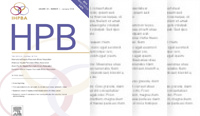International Hepato-Pancreato-Biliary Association
HPB Blog, June 2018

When a patient presents with obstructive jaundice secondary to a head of pancreas cancer it remains uncertain as to whether it is better to go straight to surgery or undertake preoperative biliary drainage. This question has been addressed in the current issue of HPB through a systematic review and meta-analysis from an International consortium with John Windsor as senior author. 32 studies were included in the systematic review and ten of these in the meta-analysis. Overall the study concluded that evidence does not support routine preoperative biliary drainage as a prelude to surgery. Questions remain about patients with extremely high bilirubin and the risk of renal failure from early surgery and also the practical implications of dealing with pancreatic cancer as effectively as an emergency case.
A further systematic review and meta-analysis from Chan and colleagues Melbourne, Australia explores outcomes in patients who undergo central liver resection also known as mesohepatectomy compared with extended resection. Although both surgical options are not always available in the same patient this is an important study for the management of centrally placed liver cancer. They found that mortality was similar with either approach but that complication rates overall were lower with central hepatectomy and particularly the incidence of post hepatectomy liver failure was reduced by this approach. On the same theme, Wei and colleagues from China and Russia present a series of patients who underwent mesohepatectomy for hepatocellular carcinoma.
The final review this month involved a comparative analysis of the Sendai and Fukuoka Consensus Guidelines for the management of IPMN and is presented by Srinivasan and colleagues from Singapore. This study suggests that Fukuoka has a higher positive predictive value and Sendai a lower negative predictive value in evaluating malignant IPMN. The authors caution that although both guidelines are useful they may still miss cases of invasive and even malignant IPMN.
Ong and colleagues from Duke University, explored the American College of Surgeons National Cancer Database to explore whether lymph node yield was different between open and laparoscopic portal lymphadenectomy in patients with gall bladder cancer. They found that a higher lymph node yield was obtained at open surgery and that academic and high volume centres tended to use an open approach and achieve higher lymph node yield. Lymph node yield was not actually associated with overall survival but is considered an indicator of oncological clearance and the authors recommend that consensus guidelines should define more clearly the goals of lymphadenectomy in this disease.
The debate about whether to drain pancreatic resections and when to remove the drain if you do, is continued by Villane-Ferriol and colleagues in a collaborative study which recommends that day 3 drain amylase content of <350 U/l is associated with a low fistula rate and low complication rate compared with if amylase level is higher.
Beard and colleagues from Rhode Island, Pittsburgh and West Virginia University describe a series of patients with hepatocellular carcinoma who underwent laparoscopic liver resection. The series is unusual in that it includes a significant number of Childs B and C patients and the authors found that resection could be undertaken safely even in carefully selected patients with significant liver disease.
On the same theme Chong and colleagues from China and Hong Kong present an article showing better survival outcomes for propensity scoring matched patients with HCC and marginal liver function who underwent microwave ablation compared with surgical resection.
Khan and colleagues present some interesting data on MUC13 expression in pancreatic cancer providing evidence of nuclear MUC13 expression as a marker of cancer aggressiveness.
Still on the subject of pancreatic cancer, de Geus and colleagues from Boston and Leiden interrogated the National Cancer Database to look at the effects of neoadjuvant therapy. They found that the use of neoadjuvant therapy reduced the rate of R1 and R2 resections but if margins were positive outcomes were very poor, irrespective of whether the patient had received noadjuvant therapy. The article calls for diligence in ensuring complete surgical clearance in all resected patients and the remaining need for post-operative chemotherapy.
Articles on near infrared cholangiography to enhance visualization of the biliary tree in cholecystectomy and perioperative infection screening in patients undergoing pancreaticoduodenectomy complete the June issue of HPB which we hope you will enjoy.
Stephen J Wigmore
Corporate Partners
If you are interested in becoming a Corporate Partner of the IHBPA please contact industry@ihpba.org
Find out more


